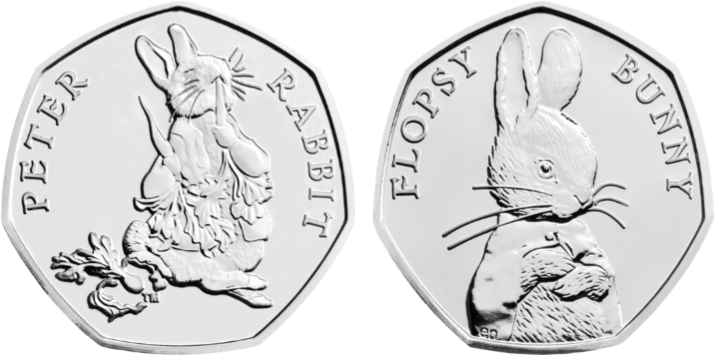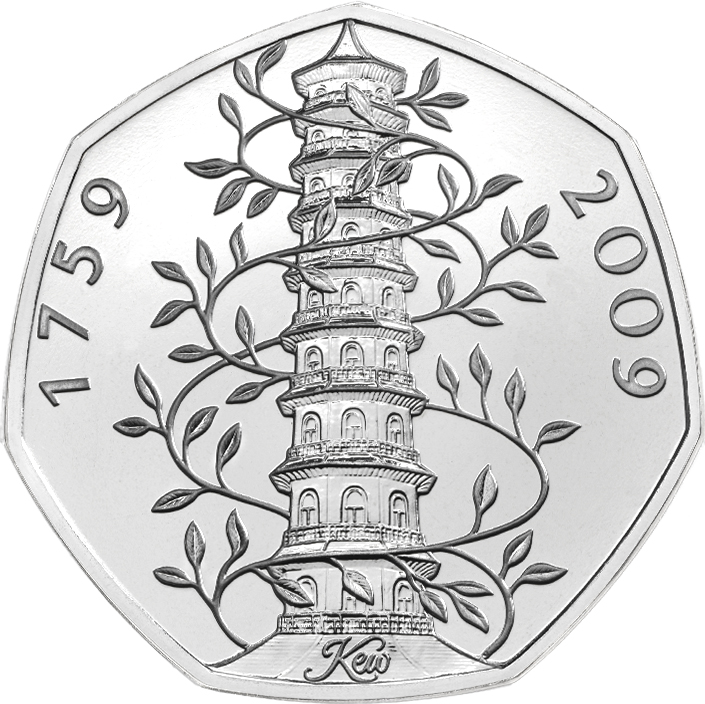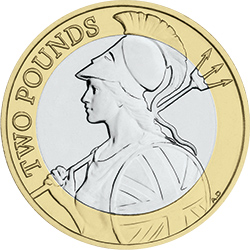Posts Tagged ‘Coin News’
Official UK Brexit 50p released!
*** UPDATE ***
An extra 1.5 million Brexit 50ps have been released into circulation following the 3 million initially released when Britain left to EU.
The Treasury has confirmed the number of Brexit 50p coins will increase to 10 million by the end of the year to satisfy collector demand.
On the 31st January 2020 the United Kingdom left the European Union – over three and half years after the Vote.
This departure is possibly one of the most historically significant events to happen in modern history, so we know collectors will be extremely excited to hear a brand new United Kingdom coin has been issued to commemorate the occasion.
The 2020 UK Brexit 50p has been officially released today and is the only official United Kingdom coin to commemorate the occasion.

Although the design had been rumoured some time ago, the final design features the inscription ‘Peace, prosperity and friendship with all nations‘ and the all-important date – 31st January 2020 – underneath.
However, this brand new 50p isn’t the only coin to have been issued to documents Britain’s relationship with the European Union.
In this blog, we take a look back at the coins which tell the story of the 43 year long partnership between the UK and the EU.
1973 European Economic Community 50p
In 1973, after over a decade of debate and discussion, Britain was finally successful in joining the EU – then known as the European Economic Community (EEC).
To mark such a ground-breaking partnership, The Royal Mint issued the FIRST-EVER commemorative 50p!
It’s hard to believe there was a time when commemorative 50p coins weren’t commonplace, but this 1973 coin was the very first of its kind!
The design features nine hands clasping each other in a circle, symbolising the nine member state of the community.
As the first-ever commemorative 50p, it’s unsurprising this release is considered hugely significant in British history, numismatic history, and is a staple of any UK coin collection. You can secure one for your collection for JUST £5.00 by clicking here >>
The 1973 EEC 50p had a circulating mintage of 89,755,000.
1992/3 European Council Presidency 50p
In 1992/3 the UK celebrated its presidency of the European Council of Ministers, and the completion of the Single Market.

The intricate design of this 50p, by Mary Milner Dickens (who later designed the 2000 Libraries and the 2003 Suffragettes 50ps) shows a conference table seen from above, around which are the 12 chairs for the Council of Ministers.
However, what makes this 50p particularly special and sought-after by collectors is not the design, but the mintage.
This 1992/3 European Community Presidency 50p had a circulating mintage of JUST 109,000! It is the rarest UK 50p to EVER enter circulation.
When you consider the Kew Gardens is the rarest 50p currently in circulation and has a mintage of 210,000 you start to grasp how small the mintage for this 50p really is!
Any Change Checker who is lucky enough to have this coin in their collection must be incredibly pleased!
1998 UK Entry to the EEC 25th Anniversary 50p
In 1998 a new United Kingdom 50p was issued to commemorate 25 years since the UK joined the EEC.
Remarkably, this European-Union-inspired 50p coin is the subject of another numismatic first – the first ‘new sized’ commemorative 50p to be issued following the specification change in 1997.

The old larger coins were removed from circulation and it’s this new sized 50p that has featured some of our most iconic coin designs and has become the most collected coin in the world!
Designed by John Mills (designer of the much-loved 1994 D-Day 50p), the reverse of this coin shows 12 stars to represent the 12 ministers and had a circulating mintage of 5,043,000.
And there we have it! The UK’s relationship with the EU as told by coins!
It’s incredible to look back at some of the most ground-breaking 50p issues that are tied to this 47 year relationship.
Do you have any of these coins in your collection? Let us know in the comments below!
Brand new UK Brexit 50p – Secure yours today
As you would expect with a coin this historic the brand new UK Brexit 50p has been struck to superior Brilliant Uncirculated quality and protectively encapsulated in official Change Checker packaging to preserve its quality forever.
The history of the ‘Ten Bob’ note – a world before the 50p coin…
Back in the 1960’s the 10 Shilling Note, or ‘ten bob’ as it was commonly known, would go pretty far – buying you 6 pints of beer, 10 loaves of bread, or 17 pints of milk.
Nowadays it’s hard to imagine the decimal equivalent, the 50p, buying so much. In fact, 50p can only just buy you one pint of milk today! And you can certainly forget that pint of beer!
But before the much loved 50p came along, the old 10 Shilling banknote had a fascinating history.
From being issued by the Government in a wartime emergency, changing colour to avoid forgery from the Nazis and eventually being replaced by the world’s most popular coin, it’s important that the history of the ten bob isn’t forgotten.
The Emergency Banknote
In August 1914, the British economy was in turmoil due to the instability caused by the oncoming war on the continent.
Bankers and politicians were desperately looking for ways to secure Britain’s finances and prevent the banks from collapsing.
The Government decided that a large supply of banknotes should be made available for the value of 10 Shillings, making it easy for the public to make small transactions.
However, The Bank of England was not able to prepare and print the required number of notes quickly enough, so the Government took the unprecedented step of deciding to issue the notes itself.

These banknotes became known as the Treasury banknotes and were unlike anything the British public had ever seen.
Until this point the lowest denomination banknote was £5, and in those days this was such a large sum that many people would never have seen or used a banknote before.
By issuing a 10 Shilling banknote, the Treasury created the first widely circulated banknotes in England.
The Wartime colour change
In 1928, the responsibility for printing 10 Shilling notes was transferred to the Bank of England.
However, not long afterwards, Britain once again found itself at war and again found its currency under threat.
During World War II, Nazi Germany hatched a plan to undermine British currency.
Through ‘Operation Bernhard’ they believed they had discovered a method to manufacture counterfeit ‘White Fivers’, and planned to distribute these in huge numbers to destabilise the British currency.
The Bank of England decided to take preventative action and, as a result, the 10 Shilling note was changed for the duration of the war to a distinctive pink and blue colour in an attempt to prevent counterfeiting.

It was also revolutionary in the progression of banknote technology by incorporating a metal security thread.
The Nazis couldn’t compete with this high level anti-forgery technology and hence the British 10 Shilling note held strong and supported the British wartime economy, as it had done since its conception.
The 50p revolution
After undergoing a colour change during the Second World War, the ten bob note reverted to its familiar red-brown until 1961, when a new design featuring a portrait of Queen Elizabeth II was introduced.
Despite a new design for the 10 Shilling note featuring Sir Walter Raleigh on the reverse being approved in 1964, as part of the process of decimalisation it was dropped in favour of the new fifty pence coin introduced in 1969.

The principle reason for the change was to save the Treasury money.
The notes had an average lifetime of around five months, whereas a coin could last for fifty years.
The 50p has since gone on to become the world’s most popular and collected coin, but nowadays few realise the fascinating history of its predecessor, the 10 Shilling banknote!
Do you remember the ten bob note? Let us know in the comments below!
If you’re interested in coin collecting, our Change Checker web app is completely free to use and allows users to:
– Find and identify the coins in their pocket
– Collect and track the coins they have
– Swap their spare coins with other Change Checkers

Sign up today at: www.changechecker.org/app
Rarest 50ps Revealed! 2018 Mintage Figure Update
Exciting news! The Royal Mint have revealed the latest mintage figures for 2018 coins!
Seven 50p coins entered circulation in 2018 and collectors across the nation have been debating how rare each one might be.
But now the official figures have been revealed and it looks like there are some particularly rare ones we should be looking out for…

The rarest Beatrix Potter 50ps
Collectors who have held on to their 2018 Beatrix Potter 50ps will be delighted to see that these coins have lower mintages than any of the previous Beatrix Potter coins issued in 2016 and 2017.
In fact, three out of the four Beatrix Potter 50ps released in 2018 are even rarer than the 2016 Jemima Puddle-Duck 50p – previously thought of as the rarest Beatrix Potter 50p in circulation!

With a mintage of just 1,400,000 the 2018 Peter Rabbit and 2018 Flopsy Bunny 50ps are sure to become incredibly sought-after amongst collectors, as they take joint second spot on our mintage figure chart (which excludes Olympic 50ps).
These two coins, alongside the 2018 Mrs Tittlemouse (mintage: 1,700,000) have pushed the 2017 Sir Isaac Newton (mintage: 1,801,500) off the podium.
Whilst the 2018 Tailor of Gloucester has a slightly higher mintage at 3,900,000 the other three coins in the 2018 series have only been pipped to the post by the UK’s rarest 50p in circulation, the Kew Gardens.
With a mintage of 210,000 this 50p is considered the holy grail of change collecting and dominates the Change Checker mintage figure charts and Scarcity Index.

What about the Olympic 50ps?
In 2012, the release of the Olympic 50p series kick started a collecting frenzy across the nation.
It’s estimated that around 75% of these coins have been removed from circulation by collectors which means they are incredibly sought-after, especially considering these 50ps have some of the lowest mintage figures in circulation…
Many of the Olympic 50ps have a mintage less than 2,000,000 with the rarest (the Olympic Football 50p) having a mintage of just 1,125,500.

Taking these rare 50ps into consideration, the 2018 Peter Rabbit and Flopsy Bunny coins would sit in joint sixth position, below the Kew Gardens, Football, Wrestling, Judo and Triathlon 50ps.
£2 Coin Update
As well as updating the 50p mintage figures, The Royal Mint also revealed that no £2 coins were issued into circulation last year.
There have been no new £2 coins issued into circulation since 2016, which may in part be due to the introduction of the new 12-sided £1 coin in 2017.
The new definitive £2 was released in 2015, replacing the Technology £2 with a Britannia design, but for the past two years it seems there has not been enough demand to issue this coin for circulation.

In fact, aside from the £1 coin, no new definitive coins were released at all last year, from the 1p to the £2 coin.
A-Z 10p update
Despite no definitive 10p coins entering circulation in 2018, The Royal Mint have confirmed mintage figures for the highly popular A-Z of Great Britain 10p coins.
From Angel of the North to Zebra Crossing, 26 new 10p designs were released in 2018 to celebrate what makes Britain British.

Initially, 2.6 million of these coins were released, followed by another 2.6 million later in the year.
However, up until now the individual mintages for each design had not been confirmed.
The mintage figure update now reveals that 220,000 of each design entered circulation in 2018, which makes the individual 2018 10p coins almost as rare as the Kew Gardens 50p…
Have you been lucky enough to find any of these coins in your change? It’s always exciting when new mintage figures are revealed and your realise just how rare the change in your pocket really is!
We’ll be updating the Change Checker Scarcity Index next month and it will be exciting to see how these new figures impact the index.
If you’re interested in coin collecting, our Change Checker web app is completely free to use and allows users to:
– Find and identify the coins in their pocket
– Collect and track the coins they have
– Swap their spare coins with other Change Checkers

Sign up today at: www.changechecker.org/app







